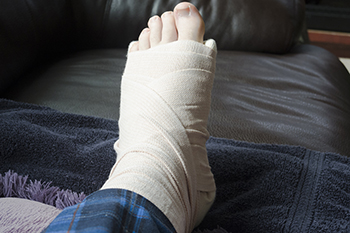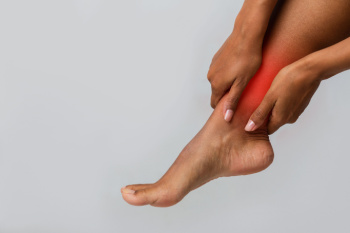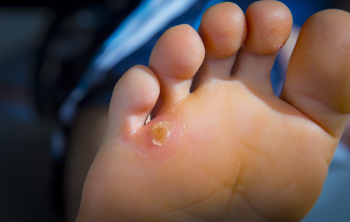Connect With Us
Blog
Items filtered by date: March 2024
Gout Pain Can Be Managed
Types of Metatarsal Foot Fractures

Metatarsal fractures encompass a variety of injuries, from acute trauma to stress fractures in the five long bones of the feet. Acute metatarsal fractures occur suddenly, often due to forceful impact, like dropping a heavy object on it or sports-related incidents. These fractures can be open, where the skin is broken, or closed, and may be displaced, requiring realignment and stabilization by a podiatrist. The fifth metatarsal bone is particularly prone to acute fractures, commonly occurring at various points along its length. Stress fractures, on the other hand, develop gradually from repetitive pounding, resulting in hairline cracks that may be difficult to detect. However, they still require proper diagnosis and treatment to prevent worsening symptoms. Recognizing the signs of metatarsal fractures and seeking timely medical attention from a podiatrist is important. If you suspect a metatarsal fracture or experience midfoot pain it is suggested that you make an appointment with a podiatrist for an exam, diagnosis, and treatment options.
A broken foot requires immediate medical attention and treatment. If you need your feet checked, contact Chuc Dang, DPM from California . Our doctor can provide the care you need to keep you pain-free and on your feet.
Broken Foot Causes, Symptoms, and Treatment
A broken foot is caused by one of the bones in the foot typically breaking when bended, crushed, or stretched beyond its natural capabilities. Usually the location of the fracture indicates how the break occurred, whether it was through an object, fall, or any other type of injury.
Common Symptoms of Broken Feet:
- Bruising
- Pain
- Redness
- Swelling
- Blue in color
- Numbness
- Cold
- Misshapen
- Cuts
- Deformities
Those that suspect they have a broken foot shoot seek urgent medical attention where a medical professional could diagnose the severity.
Treatment for broken bones varies depending on the cause, severity and location. Some will require the use of splints, casts or crutches while others could even involve surgery to repair the broken bones. Personal care includes the use of ice and keeping the foot stabilized and elevated.
If you have any questions please feel free to contact our office located in Westminster, CA . We offer the newest diagnostic and treatment technologies for all your foot and ankle needs.
Possible Causes of Sudden Ankle Pain

Sudden ankle pain can stem from various health conditions or injuries. Arthritis, including osteoarthritis or rheumatoid arthritis, may cause inflammation and pain in the ankle joint. Lupus, an autoimmune disease, can also lead to joint pain, including in the ankles. Gout, characterized by sudden and severe pain due to uric acid buildup, may affect the ankle joint. Bursitis, an inflammation of the fluid-filled sacs around joints, can cause ankle pain and swelling. Fallen arches may result in strain and discomfort in the ankle area. Achilles tendonitis, an inflammation of the Achilles tendon, can cause pain at the back of the ankle. Infections, such as cellulitis or osteomyelitis, can lead to sudden onset ankle pain and swelling if the ankle is affected. Diagnosing ankle pain typically involves a physical examination, imaging tests like X-rays or MRI scans, blood tests, and sometimes joint aspiration to determine the underlying cause accurately. If you experience sudden ankle pain, it is strongly suggested that you make an appointment with a podiatrist for care.
Ankle pain can have many different causes and the pain may potentially be serious. If you have ankle pain, consult with Chuc Dang, DPM from California . Our doctor will assess your condition and provide you with quality foot and ankle treatment.
Ankle pain is any condition that causes pain in the ankle. Due to the fact that the ankle consists of tendons, muscles, bones, and ligaments, ankle pain can come from a number of different conditions.
Causes
The most common causes of ankle pain include:
- Types of arthritis (rheumatoid, osteoarthritis, and gout)
- Ankle sprains
- Broken ankles
- Achilles tendinitis
- Achilles tendon rupture
- Stress fractures
- Tarsal tunnel syndrome
- Plantar fasciitis
Symptoms
Symptoms of ankle injury vary based upon the condition. Pain may include general pain and discomfort, swelling, aching, redness, bruising, burning or stabbing sensations, and/or loss of sensation.
Diagnosis
Due to the wide variety of potential causes of ankle pain, podiatrists will utilize a number of different methods to properly diagnose ankle pain. This can include asking for personal and family medical histories and of any recent injuries. Further diagnosis may include sensation tests, a physical examination, and potentially x-rays or other imaging tests.
Treatment
Just as the range of causes varies widely, so do treatments. Some more common treatments are rest, ice packs, keeping pressure off the foot, orthotics and braces, medication for inflammation and pain, and surgery.
If you have any questions, please feel free to contact our office located in Westminster, CA . We offer the newest diagnostic and treatment technologies for all your foot care needs.
Types and Causes of Toe Arthritis

Toe arthritis comes in various forms, each with its triggers and symptoms. Osteoarthritis, which is often spurred by wear and tear or injury, gradually erodes the cartilage between toe bones. Rheumatoid arthritis unleashes inflammation throughout the body, causing redness, warmth, and swelling in the toes, along with systemic symptoms like fatigue. Gout, driven by uric acid crystal formation, particularly targets the big toe and can be influenced by genetics, diet, alcohol intake, and obesity. Psoriatic arthritis, an autoimmune condition, often causes skin lesions that precede joint symptoms. For suspected toe arthritis, a podiatrist can offer a comprehensive assessment, including medical history, physical examination, X-rays, and possibly joint fluid analysis, to pinpoint the type and extent of the condition. For help with your toe pain, it is suggested that you make an appointment with a podiatrist.
Arthritis can be a difficult condition to live with. If you are seeking treatment, contact Chuc Dang, DPM from California . Our doctor can provide the care you need to keep you pain-free and on your feet.
Arthritic Foot Care
Arthritis is a joint disorder that involves the inflammation of different joints in your body, such as those in your feet. Arthritis is often caused by a degenerative joint disease and causes mild to severe pain in all affected areas. In addition to this, swelling and stiffness in the affected joints can also be a common symptom of arthritis.
In many cases, wearing ill-fitting shoes can worsen the effects and pain of arthritis. Wearing shoes that have a lower heel and extra room can help your feet feel more comfortable. In cases of rheumatoid arthritis, the arch in your foot may become problematic. Buying shoes with proper arch support that contour to your feet can help immensely.
Alleviating Arthritic Pain
- Exercises that stretch the foot can prevent further pain and injury and increase mobility
- Most of the pain can be alleviated with anti-inflammatory drugs, heat, and topical medications
- Massages can help temporarily alleviate pain.
It is best to see your doctor for the treatment that is right for your needs and symptoms. Conditions vary, and a podiatrist can help you determine the right method of care for your feet.
If you have any questions, please feel free to contact our office located in Westminster, CA . We offer the newest diagnostic tools and technology to treat your foot and ankle needs.
Differences Between Calluses and Corns on the Feet
 Foot corns and calluses can have similar causes but are two different conditions often found on different parts of the feet. Both calluses and corns are areas of thickened skin caused by repeated friction or pressure. Calluses typically form on weight-bearing areas, like the soles of the feet, and are usually larger than corns. They are the skin's natural response to protect against excessive pressure. On the other hand, corns tend to be smaller and have a more concentrated core. They often develop on non-weight-bearing areas, such as the tops or sides of toes. Corns result also from friction or pressure, and ill-fitting shoes or toe deformities can contribute. While calluses and corns are generally harmless, they can become painful or problematic. If you suspect a corn or callus on your foot, it is suggested you seek diagnosis and treatment advice from a podiatrist.
Foot corns and calluses can have similar causes but are two different conditions often found on different parts of the feet. Both calluses and corns are areas of thickened skin caused by repeated friction or pressure. Calluses typically form on weight-bearing areas, like the soles of the feet, and are usually larger than corns. They are the skin's natural response to protect against excessive pressure. On the other hand, corns tend to be smaller and have a more concentrated core. They often develop on non-weight-bearing areas, such as the tops or sides of toes. Corns result also from friction or pressure, and ill-fitting shoes or toe deformities can contribute. While calluses and corns are generally harmless, they can become painful or problematic. If you suspect a corn or callus on your foot, it is suggested you seek diagnosis and treatment advice from a podiatrist.
If you have any concerns regarding your feet and ankles, contact Chuc Dang, DPM of California . Our doctor will treat your foot and ankle needs.
Corns: What Are They? and How Do You Get Rid of Them?
Corns can be described as areas of the skin that have thickened to the point of becoming painful or irritating. They are often layers and layers of the skin that have become dry and rough, and are normally smaller than calluses.
Ways to Prevent Corns
There are many ways to get rid of painful corns such as wearing:
- Well-fitting socks
- Comfortable shoes that are not tight around your foot
- Shoes that offer support
Treating Corns
Treatment of corns involves removing the dead skin that has built up in the specific area of the foot. Consult with Our doctor to determine the best treatment option for your case of corns.
If you have any questions please feel free to contact our office located in Westminster, CA . We offer the newest diagnostic and treatment technologies for all your foot and ankle needs.
